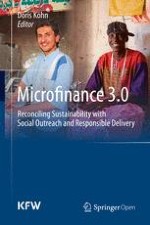
Open Access 2013 | OriginalPaper | Chapter
Armageddon or Adolescence? Making Sense of Microfinance’s Recent Travails
The pendulum of public perception is swinging against microfinance. That leaves the thoughtful observer, wary of extreme claims in any direction, with a puzzle. Is microfinance a bane or a boon or in between? This paper reviews the triumphs and troubles of the microfinance industry. It then sets forth a frame for assessing the impact of microfinance, one that helps put the recent challenges in perspective. And it offers some thoughts, in light of these difficulties, about key tasks going forward. It concludes that microcredit stimulates small-scale business activity, but that the best available evidence fails to show it reducing poverty. Its ability to empower people, especially women, is also ambiguous. Still, there is no question that all people need financial services. The main achievement of the microfinance movement has been the founding of businesses and businesslike non-profits that are delivering these services to millions of people on a sustainable basis.
The core problem facing the industry is that just as a stable banking system is more than a bunch of banks, a microfinance industry is more likely to be safe and resilient if it contains not just microfinance institutions, but credit bureaus, consumer protection laws, effective regulators, and more; and many of these other institutions are weak or absent in poor nations. It is hard (though not impossible) for donors and social investors to improve them. Yet the stronger they are, the higher is the safe speed limit for growth of microfinance institutions. The weaker they are, the more that microfinance institutions will need to internalize limits on their behavior and growth. Key steps may include giving those with an institutional commitment to the “social bottom line,” such as representatives of non-governmental organizations, public agencies or social investors, a formal role in microfinance institution governance; creating systems for defining and enforcing responsible lending behavior; and building collective arrangements such as an international credit bureau to monitor and modulate aggregate investment flows into microfinance markets.